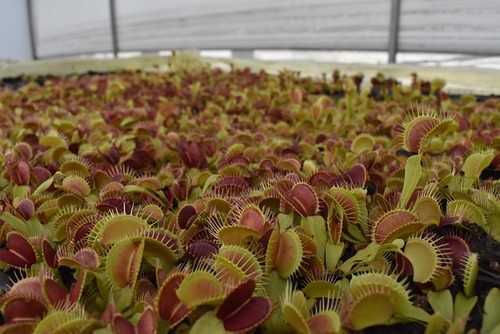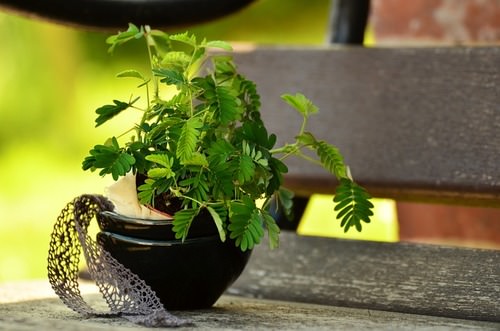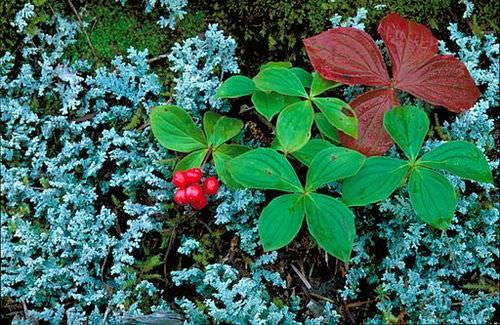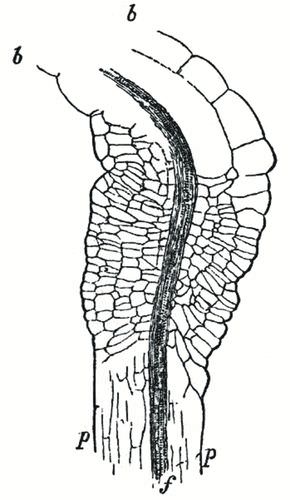13.65 植物的纳米移动 -- -- 先进
章节大纲
-
Nastic Movements
::纳米运动Nastic movements differ from in two ways:
::纳米运动有两种不同方式:-
The direction of the response is independent of the direction of the
stimulus
.
::对策的方向与刺激措施的方向无关。 -
Changes in
osmotic pressure
, rather than growth, cause this kind of movement.
::表面压力的变化,而不是增长, 导致了这种运动。
Like tropisms, nastic movements are to environmental stimuli. However, as changes in content, nastic movements are reversible. Their frequency depends on the intensity of the stimulus. The types of stimuli are similar to those which govern tropisms: light (photonasty), darkness (nyctinasty), chemicals (chemonasty), water (hydronasty), temperature (thermonasty), gravity (geonasty), and touch (thigmonasty).
::与对流体一样,鼻孔运动是环境刺激物,然而,随着含量的变化,鼻孔运动是可逆的,其频率取决于刺激的强度。刺激物的类型与对流体的刺激物类型相似:光(磷酸盐 ) 、 黑暗(鼻涕 ) 、 化学(化学 ) 、 水(氢盐 ) 、 温度(温度) 、 重力(温度) 、 重力(温度) 和触碰(毒性 ) 。Probably the most famous nastic movement is the capture of by the Venus fly trap ( Figure ). Three sensitive hairs on the inside surface of the trap are mechanoreceptors (receptors which detect movement), and two of them must be stimulated in in order for the trap to close. This prevents response to falling twigs and debris.
::最有名的麻醉运动可能是被金星苍蝇陷阱捕捉(Figure ) 。 陷阱内表面有三种敏感的毛毛是机械机感应器(感应器可以检测运动 ) , 其中两种必须被刺激才能关闭陷阱。 这防止了对落下的树枝和碎片的反应。-
Edit here for caption
::编辑此标题 -
Edit here for caption
::编辑此标题
Venus fly trap demonstrates thigmonasty; when two of the three sensitive hairs on each side of its trap are touched in close succession, the trap snaps shut within about 100 milliseconds. Prayer plants raise their leaves vertically at night, and hold them horizontally during the day – an example of photonasty. Mimosa leaves fold if touched – another example of thigmonasty. All of these changes are reversible and repeatable, and depend on osmotic change, so they are classified as nastic movements. Another famous thigmonasty included in this set of videos is the folding of Mimosa leaves in response to touch. The videos demonstrate that the strength and speed of the response depends on the speed of the stimulus.
::这组视频中另一个著名的图案是米莫萨离开的折叠,以回应触碰。 视频显示反应的力度和速度取决于刺激的速度。Prayer plant leaves move downward to a horizontal position in the morning, maximizing light exposure, and upward at night, probably minimizing water loss. This response to darkness is nyctinasty.
::祷告植物的叶子在早晨向下移动到水平位置,最大限度地增加光照射,在夜间向上,可能最大限度地减少水的流失。 这种对黑暗的反应是内分泌的。By far the fastest plant movements known involve “catapulting” pollen with stored elastic energy calculated to be 800 times that of space shuttle liftoff. Bunchberry petals ( Figure ) flip backward to release cocked filaments hinged to pollen-holding containers. Film speeds of 10,000 frames per second were required to catch the action; see photos in the Nature article referenced in Further Reading. Similar movements in white mulberries hold the record - moving petals at nearly half the speed of sound!
::迄今已知最快的植物运动包括“加速”花粉,其储存的弹性能量计算为航天飞机升空的800倍。Bonchberry 花瓣(Figure)向后翻转,以释放盖住花粉的丝状物,这取决于持有花粉的容器。每秒需要10 000个框架的胶片速度才能赶上动作;见《大自然》文章中引用的照片,《进一步阅读》中引用。白色木莓的类似运动记录了记录——移动花瓣的速度接近声音速度的一半!Bunchberry petals (actually sepals) store elastic energy in filaments which catapult pollen into the air with a force calculated to be more than 800 times space shuttle lift-off. Insects trigger the opening, and the movement depends on hydration, so this movement can be classified as thigmonasty. Let’s look at one example of how changes in osmotic pressure can cause plant movements. Thigmonastic and nyctinastic leaf movements – as in Mimosa and prayer plants - depend on a joint-like thickening at the base of the petiole or leaflet, called a pulvinus (Darwin’s drawing shown in Figure ). A pulvinus has a vascular core surrounded by a cylinder of spongy, thin-walled parenchyma ( pulvinus = cushion). The parenchyma expands and contracts in response to changes in osmotic pressure. When phloem cells in the vascular core move sugar into intercellular space, potassium ions from surrounding cells follow. These changes make the intracellular space hypertonic , so that water flows rapidly out of the parenchyma, and the joint bends. The direction of bending depends on differential shrinking and swelling on opposite sides of the pulvinus. Studies show that Calcium ions and the cytoskeleton may be involved, as well. Heliotropism (as in sunflowers) results from differential shading of cells in the pulvinus, which changes as the sun moves across the sky throughout the day. The sleepless mutant of the Japanese lotus has petioles in place of pulvini and is unable to close its leaves at night.
::让我们来看看一个关于表面压力变化如何导致植物运动的例子。 象米莫萨和祈祷植物那样,Tigmonaistic 和 nytinic 叶子运动 — — 象Mimosa和祈祷植物一样 — — 依赖于在Pulvinus(图中显示的Darwin的图画 ) 的底部联合加厚。 一个Pulvinus 的血管核心被一气球、薄壁壁薄壁面(pulvinus = 衬垫)环绕着。 近视和耐敏性叶运动 — — 在血管核心的细胞细胞细胞将糖移入细胞间空间时,周围细胞中的钾离子会随之而来。 这些变化使得细胞内空间的高度气候,因此水会迅速流出皮肤和联合弯曲。 弯曲的方向取决于阴唇两侧的差异缩小和膨胀。 研究表明,日冕太阳和细胞系骨质骨质运动会扩大和日间静止的沙丘质运动,而日间变化则会从太阳系的变。Many nastic movements involve a pulvinus – a joint-like column of thin-walled cells surrounding a vascular core, at the base of a leaflet or petiole (p). Osmotic changes on one side or the other have the same effect as differential growth caused by auxin – only the effect is much more rapid. Movements which depend on the pulvinus happen as changes in osmotic pressure take place, but (preceded by active transport) can also be used to store tension. Bunchberry pollen-catapulting has been shown to depend on hydration, and the snapping of Venus fly trap and suction of bladderwort, discussed in the lesson on , also appear to involve tension set up by and osmosis. The entire pathway for nastic movement - from stimulus through receptor to effector and effect - is not completely understood (and beyond the scope of this text), but it is clear that plants have a surprisingly varied repertoire of movements.
::取决于Pulvinus运动的移动随着表面压力的变化而发生,但(先用主动运输方式)也可以用来储存紧张气氛。 Bonchberry花粉的栽培已经证明依赖于水分,而在教训中讨论的金星苍蝇捕捉和囊囊肿抽吸的情况似乎也涉及由宇宙造成的紧张气氛。从刺激到受体到效果和效果的整个麻醉运动路径(从刺激到受体到效果和效果)并没有被完全理解(而且超出了本文的范围 ) , 但很明显, 植物的移动范围是千变万化的。Summary
::摘要-
Unlike tropism, nastic movement does not depend on the direction of a stimulus.
::与对流主义不同,麻醉运动并不取决于刺激措施的方向。 -
Unlike tropism, which depends on differential growth, nastic movement depends on osmotic changes.
::与依赖差异增长的对流主义不同,肾运动取决于表面变化。 -
Venus Flytrap, Mimosa, Prayer Plant, and Bladderwort demonstrate nastic movements.
::金星飞捉、米莫萨、祷告植物和布拉德沃特展示了麻醉运动。 -
The catapulting of pollen by bunchberry depends on hydration, so it is probably a nastic movement.
::花粉的喷射 取决于水分, 所以它可能是一个麻醉运动。 -
Changes in osmotic pressure can cause nastic movements directly, or indirectly by building up tension.
::表面压力的变化可直接或间接地导致麻醉运动,或通过加剧紧张而间接地造成这种运动。
-
The direction of the response is independent of the direction of the
stimulus
.



